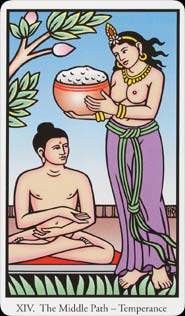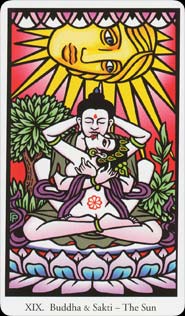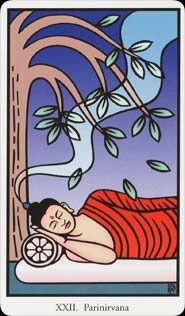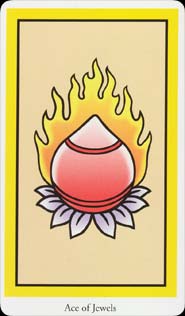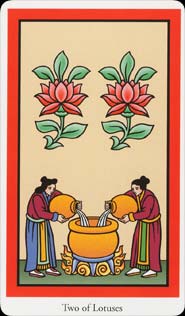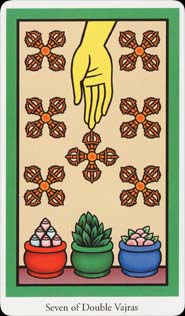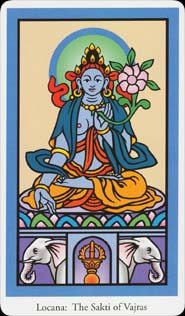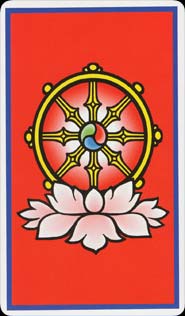Buddha Tarot Deck Review
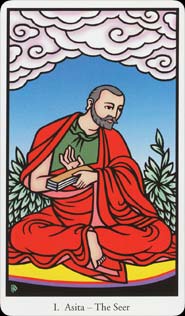
The Buddha Tarot links the Tarot trumps and the story of Siddhartha on his journey for enlightenment. The minor arcana suits are Vajras, Jewels, Double Vajras and Lotuses. Created by Robert M. Place, who also created the Tarot of the Saints and the Alchemical Tarot.
Deck Type: Tarot Deck Cards: 79
Creators: Robert M. Place
Publisher: Llewellyn 2004
Retailers
See Price at Amazon.comSee Price at Amazon.co.uk
See Price at Amazon.ca
Buddha Tarot Review by Cerulean
I was reading Susan Levitt's Introduction to the Tarot, a very good comparative guide with color illustrations to both the Thoth and Rider Waite. She opens her discussion with the idea of phrasing the question to gain the best answer, one that would have the highest benefit and also appeal to the highest chakra, the Crown.
I found this an appealing concept. I also wondered if I would ever find a lovely synthesis of East-West concepts in an especially designed tarot. My first chosen tarot was the Ukiyoe by U.S. Games, for I enjoyed a special taste for Japanese folktales and woodblock print art. They had the taste and grace of homelike familiarity for me. After awhile, I collected some other Asian style tarots for the enjoyment of the art. However I hardly ever used them as meditative or reading tarots. There are many art tarots out there that combine different concepts, including Eastern ones. I've read many enjoy the stories of the Osho Zen and also, the Roots of Asia (AG Mueller). I'm fond of the Roots of Asia for its gentle tone and beautiful night-scapes--one could put it by their bedside and be soothed with the dreamlike stories.
But I use other bright, cheerful or dramatic decks during the day. I also like historical or storylike art decks for fun and reading for others. When I saw the new Buddha Tarot, I thought this would be a storylike deck with wonderful allegories and lovely art. I've always liked the Alchemical Deck very much for its impressive beauty and art theme.
The first night that I received it, its lovely and clean graphics were quite appealing to me. The woodcut style that I associated with the Alchemical deck seemed a little more flowing and graceful in this design. I ordered the small kit with a free mesh bag and 78 page booklet (the pages are not numbered). I've bought a similar mesh bag for about five dollars and it is quite strong, despite it's gauzy appearance.
The booklet is quite complete. An eleven-page biography of Siddhartha Gutama includes his essential teachings of the Four Noble Truths and the Eightfold Path. There are three pages giving the outline of the tarot structure, nine pages describing the major arcana, and nineteen pages describing the minor arcana. The remaining eighteen pages describe three unique and excellent spreads in detail.
I believe that someone could use this tarot as both a meditational and reading deck for themselves or others just by using this booklet.
The 22 majors have a slight nod to Marseilles ordering in that Justice is number eight and Strength is eleven--however the ordering works well with the theme that Robert Place has developed.
For example, the minor cards have a color-coordinated border according to their respective suit. Each suit has a specific cardinal direction, element and human function: vajras (symbolic thunderbolt or diamond symbol) in blue represent east, air and thinking to replace swords; jewels in yellow represent south, earth and sensation to replace pentacles or coins; lotuses in red represent west, fire and feeling to replace wands, and double vajras in green represent water and intuition to replace cups.
I admire how the 22 majors, the 40 minors and 16 courts fit in the theme of this deck. An additional card illustrating the Relational Spread is a nice bonus. Finally, the back design is a yellow eight-spoked wheel sitting on a light pink eight-petaled lotus with a three-color center. The light colors of the back design are set off handsomely with a black outline and a deep rosy backround.
I believe after some study this deck will become quite familiar to me. If you were fascinated with books such as Siddhartha by Hermann Hesse and like art and cultural decks, this will be a friendly selection to you. Some initial observations in reading the booklet and observing the cards show me that I am fascinated and want to learn more about the White Tara (World) and the Morning Star with the seven chakras (Star) cards. I decided to order the book off of Amazon.com once I read the booklet and deck twice in one night.
Since I come from a more Westernized upbringing with a little acquaintance and a deep affection with Asian or Buddhist themes, this is a good learning choice for me. If you find the idea of a tarot with strong Eastern leanings a little too strange, then I would not recommend this tarot. Not everyone can get used to a dancing pose of blue feminine and half-clad dakinis instead of the regular Queen of Swords!
Buddha Tarot Review by Bonnie Cehovet
The Buddha Tarot certainly shook my world. It took me back to my junior high and high school days, where a serious interest in the study of Buddhism began for me. (Not an unusual thing, as I was living in Seattle during those years, and had many Asian friends, some of whom came from families that were practicing Buddhists.) The second phase of Buddhism in my life came when I was stationed in Hawaii during the early 70's, and had a chance to actually visit a Buddhist Temple (there is a lovely Buddhist temple off of the Pali Highway - many people visit here).
Robert Place has done some excellent work in bringing the Tarot and spirituality/religion together in previous decks/books: Tarot Of The Saints (combining Christian mythology with the Tarot Archetypes), The Angels Tarot (with Rosemary Ellen Guiley, entering the Angelic realm and working with the Kabbalah, alchemy and Christina mysticism), and The Alchemical Tarot (with Rosemary Ellen Guiley - combining alchemy with the Tarot Archetypes). I knew before I even had the deck in my hands that this was not a "make do" Tarot, where giant leaps of faith had to be made to match the life of Buddha with the Tarot Archetypes. This is amazing, considering that this is a well thought out 79 card deck (the 22nd card being Parinirvana, representing the death of the human Buddha and his attainment of total nirvana). Other than an added card, there is only one other change to the Trumps, and that is the placement of Justice as number eight and Strength as number eleven.
The LWB (Little White Book) that accompanies the deck is a wealth of information on Buddha and on the journey that represented his life. Enough background is provided so that the reader has a solid basis for understanding what the cards represent, and so that The Buddha Tarot can be easily understood and worked with, not just memorized and worked with by rote.
The life of Buddha - who he was, who his family was, where he was born - this is all discussed in a very palatable format. It is fascinating to learn that his birth was very similar to that of Jesus, and that soon after his birth a seer named Asita affirmed that there were to be two possible paths for Buddha: he had the choice of following a worldly life and being a great emperor over a unified India, or he could embrace asceticism and become a world savior - a Buddha. The journey that Buddha took to enlightenment is well presented in this booklet - including his teaching of the Four Noble Truths ( 1. All life is dukkha, suffering; 2. The cause of dukkha is tanha, desire; 3. The cure to life's suffering - dukkha, is to let go of tanha; 4. There is a method for overcoming tanha. It is called the Eightfold Path.) and the Eightfold Path ( 1. Develop right knowledge; 2. Develop right aspiration; 3. Develop right speech; 4. Develop right behavior; 5. Develop right livelihood; 6. Develop right effort; 7. Develop right mindfulness; 8. Develop right absorption).
Place follows this with a section discussing the esoteric (archetypal) aspects of Buddhism: the archetypal aspect of Buddha is called Adi Buddha, meaning the primordial Buddha. Buddha encompasses the entire cosmos, with the cosmos having a center and four cardinal directions - creating a mandala. On the plane under the Adi Buddha are five great Buddha's called jinas - Sanskrit for conquerors, referring to someone who has conquered spiritual knowledge and time. Each Jina represents a direction and the associations with that direction.
Each Tarot suit is represented by one of the Jina's, with border color for each suit representing the color associated with each specific Jina. The magickal implements associated with each Jina take the place of the traditional suit symbols.
The presentation of the cards in the LWB is done as text only, without the use of keywords. The reference is to Buddhist concepts, and how they relate to the nature of the card. There are three quite in depth spreads at the end of the booklet: The Relationship Spread* (dealing with both people and issues); a nicely expanded Chakra Spread; and an exceptional Mandala Meditation that you need both time and space to do properly (or improperly, as the case may be!). I am continually impressed by the work of Robert Place. His Chakra Spread is a prime example of the depth of his knowledge, and his willingness to share. After the cards are shuffled, cut, placed and interpreted, he recommends taking the left hand and holding it over the cards, one at a time, to see where the blocks are for the Seeker. Talk about added value! My hope is that one day I will have the opportunity to have an in person reading from Mr. Place - and I further hope that I am ready for the answers that he gives me!
*There is an extra card with the deck that nicely illustrated the nine card relationship spread.
Time to visit the cards themselves. Well, let's talk about the total presentation first. The box is done in a deep yellow, with muted lavender, green and brown tones to the graphics. The cover opens along the length of the box, which makes life very easy! There is a black mesh bag that comes with the cards that I was not sure that I was going to use. I did end up placing the cards in there to see how I felt about life, and they looked "at home". I added a rose quartz crystal and all was well with the world.
The cards are approximately 2 3/4" bt 4 5/6", on good quality glossy cardstock. The backs have a 1/4" white border, followed by a smaller deep blue border. The background is a deep orange-red, with a center glyph of a yellow eight spoked wheel, centered on an eight petaled light pink lotus. The center of the wheel is tri-colored - red, blue and green. The use of black outline makes the graphics stand out nicely. The size of the deck is very easy for smaller hands to use, but the graphic is such that it would be noticeable if a card was drawn in the reversed position.
The cards each have a border that is color coded by suit. The Trumps have the number, title and traditional Tarot equivalent across the bottom of the card. The Court Cards have the title and suit across the bottom, and the Pips have the number and suit across the bottom.
There are several cards that drew my attention, the first of which was the Middle Path (Temperance), where we see a female figure offering a large bowl of food to a male figure that is seated in the traditional lotus position. Mara (The Devil) is also quite interesting - a large figure in blue, with male and female figures in front of it. The Pips are done in a very interesting fashion - as we saw in Tarot Of The Saints, where the upper portion of the card shows the pips and the lower portion of the card shows a small scene. The Eight of Lotuses shows eight lotus symbols in the upper two-thirds of the card, with a male figure pruning, or cutting back vegetation. The Chakras (Morning Star - The Star) shows a seated figure with the chakra's marked by appropriate colors and positions, with the Crown Chakra represented by an opened lotus. The Ten of Lotuses is another favorite, showing eight lotuses in the upper two-thirds of the card, with the remaining two lotuses shown below and on either side of the eight spoked wheel that appears on the back of the deck.
For me, this is a deck for ritual, meditation and personal readings. I would have to know someone quite well before I would consider offering them the wisdom of this deck. I feel that this deck could be used readily by Tarot students/readers of all levels.
The final word on The Buddha Tarot I have reserved for Robert Place. From the LWB: "Ultimately, "The Buddha Tarot" is a mandala. As Buddha consciousness radiates through a mandala, Buddha consciousness radiates through "The Buddha Tarot".
Note: There is a companion book that is sold separately from the deck that discusses the history of Tarot through time and examines Buddhism from the Western world view. Included in the book are a detailed description of each card and how it fits into the tradition of Tarot. It is entitled The Buddha Tarot Companion and is written by Robert Place.
Buddha Tarot Review by Kate Hill
The Buddha Tarot is the latest deck from Tarot author and artist, Robert M. Place, creator of quality decks such as the Tarot of the Saints, Alchemical Tarot and Angels Tarot.
In the Buddha Tarot, Siddharthas journey to enlightenment parallels the Fools Journey of Western mysticism. Robert Place made the realisation on Christmas morning 1996, after reading Buddhist literature the night before. The more he researched the links between Buddha and Tarot, the more profound connections links between Eastern and Western wisdom were uncovered. As he says:
"This deck is not just about Buddha. It is about us and about things in our culture we may have forgotten. It is about how much our mystical heritage is like Buddhism. It is about why we can find Buddha in the Tarot, and a demonstration that the Tarot is a sacred tool, a mandala."
Buddha means one who is awake. Buddha is the perfected human being, an example to inspire us to grow into our full potential as a compassionate and kind human being. There are many Buddhas, but the most commonly known as Buddha in the West was born Siddhartha Gautama in 563BC, in what is now Nepal. His royal parents intended him to succeed them to the throne, but he grew dissatisfied with his luxurious lifestyle and left on a journey to fine the key to human happiness. After six years of learning for Hindu masters, ascetics, and trying the religious teachings and philosophies of the time Siddhartha found the Middle Path, and became enlightened. Until his death many years later, he taught the principles of Buddhism, the principles of moral living, mindfulness of actions and thoughts, and the development of wisdom and understanding.
Buddhist legend says that when Siddhartha became enlightened, he become not one but five Buddhas that represent that five divisions of the world. These five Jinas each correspond in the Buddha Tarot to the five suits of Tarot as follows:
Vajras Swords Aksobhya, Buddha of the East - Blue Air
Jewels Coins Ratnasambhava, Buddha of the South Yellow Earth
Lotuses Staffs Amitabha, Buddha of the West Red Fire
Double Vajras Cups Amojhasiddhi, Buddha of the North
Trumps Vairocana, Buddha of the Center White - Aether
The trump cards, the major arcana, illustrate significant scenes and people from Siddharthas life and journey towards becoming Buddha. His mother and father are the Empress and the Hierophant, his wife and child feature in the Lovers. Cutting his hair and renouncing his ties in Strength. Later, his time under the Bodhi tree, and his first sermon. There is also twenty third trump unique to the Buddha Tarot, titled Parinirvana, which stands for Buddhas attainment of nirvana and the ultimate reward beyond the World.
The minor arcana have been tailored to the theme of love, compassion, and right living, and instead of the usual suit emblems they depict the magical implements of each Jina Vajras, Jewels, Double Vajras and Lotuses. The number cards have the pips arranged above a simple scene, a mudra (hand gesture) or an object. The court cards depict the Jina, his female counterpart, the Sakti, his animal guardian and servant Dakini instead of King, Queen, Knight, and Page, and these figures have a skin hue the same as associated with their suit element.
Artistically, Places cards have a strong, distinctive style, with very boldly coloured artwork sharply outlined in black (similar but more pronounced than that of the Tarot of the Saints) on the face of the cards and a non-reversible design of the wheel and lotus flower on red on the backs. Used in a spread, the full-size scenes and brightness of the majors stand out decisively, while the minors fill in the background. In all of these cards, the directions of a gaze, the pointing of an arrow, the direction of travel are all important. Many cards influence and are influenced by the surrounding others.
The Buddha Tarot set from publishers Llewelln\yn includes the 79 cards, an extra card with the relationship spread printed on it; a 70 page booklet (all in English); and an black organdie bag that fits the cards and booklet exactly. (Unlike most Llewellyn sets, the comprehensive companion book is sold separately from the cards. This is a little unfortunate, as the deck would be best understood with the help of The Buddha Tarot Companion, which examines in more depth Tarot and Buddhism, and the links between.) The booklet holds very basic information on the life of Buddha and the precepts of Buddha, enough to understand the premise if you arent familiar with it. The card meanings are paragraph-long explanations without keywords and are tailored to the theme of the deck, and to explain the image. Following are two new spreads, a nine-card Relationship spread, twenty-one card Chakra Spread, and the 78 card full Mandala meditation.
On the whole, this a fascinating deck connecting seemingly disparate partners, Tarot and Buddhism. It is slightly more challenging to use for divination if youre not familiar with Buddhist imagery, as was the case for me, but its an easy way to learn and the Buddha Tarot is worth the effort.
Buddha Tarot Review by Kathleen Meadows
I think there must have been many Tarot folk, like me, anticipating the release of this deck. Robert Place's Alchemical Tarot is well used and admired deck by many, and when rumour went out that he was working on a deck based upon the teachings of Buddhism, excitement crackled. And he didn't disappoint! The Buddha Tarot is everything we hoped it would be.
It's colourful, masterful, educational and simply engaging. For those whose interests branch into Buddhist philosophy, such as Yoga enthusiasts, this deck is a must. For those Taroists who have an interest, but dont know where to begin their study, this deck will be the perfect venue to begin your foray into the teachings of Buddha. Much has been done in the area of cross referencing the Tarot with the Qabala, Wicca, Christianity, Egyptian legend, Celtic lore, and western, aboriginal spirituality but little has been written blending Buddhism and the Tarot. This especially is what makes Places work so monumental. He has named the suits, Vajras (air), Double Vajras (water), Jewels (earth) and Lotuses (fire). The Majors are replete with gods and goddesses, the Lovers card in particular is outstanding. Place has depicted Siddartha and Yasodhara as the Lovers, and writes, The Lovers card urges us to follow what we love. When a choice is to be made, it urges us to look deep and discover where our true love lies. This is not always the path of ease.
Place explains in the small, but mighty, accompanying booklet how to use the cards for chakra work leading me to imagine that this deck will be especially useful to Taroists who also have a healing practice. Like Buddhism this deck is stimulating from all four of the elements perspective; intellectually, visually, spiritually and emotionally. I think Place has created another classic that will be used and loved by Taroists for a very long time. This is also a quality, sturdy deck with an excellent finish. I highly recommend you get yourself a deck before Llewellyn sells out!
Buddha Tarot Review by Derek Armstrong
Buddha Tarot by Robert Place is at once spiritually insightful, tantrically powerful and imbued with the very essence of both Buddhism and Tarot. Well-known Tarot historian and scholar Robert Place, best known for his superb book, The Tarot, History, Symbolism and Divination, not only demonstrates a masters touch as an illustrator, he has created the first "Buddhist" Tarot deck that makes any sense in my humble opinion as a practicing Buddhist.
Originality
It is difficult to conceive of a more "originally" conceived deck. On the other hand, Place "spoils" the originality rating by coming within a hair of "proving" that Buddha's life story influenced the entire Major Arcana "Journey of the Fool." Joking aside, there can be no doubt that Place's brilliant analysis of the historical Buddha Shukyamuni's journey to Enlightenment as the "Fool's Journey" is intellectually insightful, creative, inspired, and very, very convincing. Place even presents several pages of chronology to support his theory. Everything card meshes directly with a symbolic event in Buddha's life. A brilliant concept, and without doubt with more than a hint of truth.
Artwork
There's never been any doubt of Robert Place's superior illustration style, very sensitive as always to various spiritual streams. His Alchemical Tarot and Angel's Tarot demonstrated his brilliance. The Buddha Tarot is the highest form of its expression. Deceptively simple, symbolically correct, beautiful and deep, the cards are a joy for meditation, divination, or just as lovely illustrations.
The Major Arcana
The Fools Journey becomes the Journey to Enlightenment of the Buddha, with one special and inspired addition, a 22nd "Trump" titled Parinirvana. It is certainly "optional" in readings for those who prefer the "traditional" 78 card deck.
Because Place makes the key point that the Buddha's journey actually inspired the "hero's journey" in the Major Arcana at least in part, he has adopted the more traditional 8-11 attributions of Strength as 11 and Justice as 8. This is accepted by most experts as correct when using the Major Arcana as the "Journey of the Hero."
Now, the entire cycle of the "Journey of the Fool" or "Journey of the Hero" per Joseph Conrad and Carl Jung becomes truly Enlightening, as Place journeys us through the story of the historical Buddha in the cards:
- 0 The Fool The Descent From Tusita Heaven: Buddha is conceived
- 1 Magician Asita, the Seer: Asita the magus predicts Siddhartha will become the Buddha
- 2 Priestess Maya, The Mother: Buddha's mother, who in Buddhism is quite revered, a "Queen even the Gods adored."
- 3 Empress Yasodhara, The Future Empress: Buddha's wife
- 4 Emperor Siddartha, The Future Emperor: as the prince (future emperor) of the Shakyas
- 5 Hierophant Suddhodhana, The Father: Siddartha's father, the king, who represents attachment to perfect rule and the rigor of tradition
- 6 Lovers Siddhartha and Yasodhara, the Lovers: revealing an image of Siddhartha making the choice between his wife and baby and Enlightenment to save all mankind
- 7 Chariot Siddhartha's Visit: Siddhartha's visit to the city on his chariot (a potential example of how Buddha's story, which reached Europe 200 years before Christ via Alexander the Great might have eventually influenced the Major Arcana)
- 8 Justice Karma: illustrated as the famous scene when Siddhartha excapes his father on his loyal horse Kantaka, carried silently above the ground by the Gods.
- 9 Hermit The Old Man and the Sadhu: blends two stories, Siddhartha's revelation of old age when he sees his first old man, and his encounter with the wise hermit, the Sadhu.
- 10 Wheel of Fortune Reincarnation: illustrates a fundamental Buddhist concept, the wheel of life or Samasara, or Karmic wheel, very beautifully illustrated with a cock, pig and snake swallowing each other's tales in a wheel, and revealing the cycle of life and attachments that keep us "trapped."
- 11 Strength Siddhartha Cuts His Hair: A highly moving scene from Buddha's life, where he has chosen his sacraficial path and symbolically cuts off his "princely lock" to show his inner resolve and strength. He then strips himself of his luxuries and clothes and goes naked into the world.
- 12 The Hanged Man The Invalid, the Suffering Man: Siddhartha succors a suffering man, realizing that he must himself sacrifice all to save mankind.
- 13 Death The Corpse: Siddhartha's revelation comes when he witnesses a death and funeral. In Buddhism death is quite a different concept from "Western" ideas. Once the body is discarded, the change is profound. The body is meaningless, and the person is reborn (if the journey is incomplete) or if Enlightened becomes either a Bodhisattva or a Buddha.
- 14 Temperance The Middle Path: Siddhartha's main teaching is the Middle Path, the balanced path between the extremes of the physical and the spiritual, highly appropriate to this card.
- 15 Devil Mara: Mara is actually a god, not "the Devil" but he is a mara, an earthly god who's name means "delusion." By keeping man attached to cravings and pleasures, he enslaves us to Samsara. Buddha taught an escape and as a result he confronts Mara as he meditates on Enlightenment under the Bodhi Tree. Mara sends his sensuous daughters to tempt Buddha and warriors to kill him, but all is revealed as illusion and fades away.
- 16 The Tower The Flaming Disc: In a dramatic scene under the Bodhi tree, Mara flings his greatest weapon at Buddha (of course this is symbolic of the struggle in Buddha's own mind as he faced temptations and cravings and fear), a flaming disc of ruin (the Tower). Buddha realizes it is illusion and the disc turns to flowers.
- 17 Star The Chakras, The Morning Star In the early evening of his Enlightenment, Buddha released his "psychic" energies by releasing each of his chakras, illustrated in this card.
- 18 Moon Wesak, the Full Moon: On that last night, after Mara's defeat, the moon is full (Wesak) and it is Siddhartha's 35th birdhday. Now, Buddha, Enlightened, sees all his previous hundreds of lives and realizes the truth of attachment and delusion.
- 19 Sun Buddha and Sakti: Tantric completion of enlightenment involves an understanding that within each of us is a complete male and female both. The "sexual" embrace of Buddha revealed in the Sun card represents that completion (often misunderstood by non-Buddhists.) Place here, explains at length how Buddha, now enlighened, became one with the Cosmic Buddhas and the Sakti's, which really means he became one with the true Universe in completion.
- 20 Judgement The First Sermon: I would have called it Deerpark, less "Western" than "sermon", or "turning of the wheel" both highly meaningful in Buddhist thinking. Buddha now taught his followers in Deerpark the noble truths.
- 21 World White Tara: Tara is the ultimate Female Buddha, the Mother of All Buddhas, and the World or Universe itself. Tara holds a special place in Buddhists heart as the savioress of the world.
- 22 Parinirvana I had expected Parinirvana to become the World card, but Place gave it a special place with a new card. Parinirvana is Buddha's ultimate completion, as he finally left the world.
The Mandala of Cards
Brilliantly, and this to me shows Robert Place's true inspiration and spiritualism, Place anchored the minor arcana to the four cosmic Buddhas of Mahayana and Vajrayana. Basically, since Buddha transcended everything, he became everything and the Cosmic Buddhas are symbolic of this. Each of the great Buddhas become a "king" of their elemental minor arcana suit.
I mention this here because Place built an entire Manadala out of the cards. It is such a thrilling experience to actually lay these cards out. I felt most "monk-like" and enlightened. Starting with the WHITE TARA World card, which has four colors representing the four directions and four suits and four Buddhas, Place gives a map for laying out a sacred Mandala using all the cards. Then, in symbolic "destruction of illusion" after meditating on your six-foot layout of cards, you sweep them all back into the deck. It's very moving for a Buddhist, who might have watched Tibetan monks work for days on their sand mandalas only to sweep them away to show the world's impermanence and illusion.
Minor Arcana
This may take a moment of "adjustment" for non-Buddhists users of these magnificent cards, but the suits are appropriately changed to represent the elements and directions of Buddhist (and most eastern) practice. Directional elements are "turned around" because Eastern spiritual paths and magical pathworkers choose directions appropriate to their world. Buddhists, Hindu and Doaist path workers will all work well with these attributions:
Wheel = Trumps = Aether = Center = White = Vairocana Buddha
Lotuses = Staffs (Wands) = FIRE = West = Red = Amitabha Buddha
Double Vajras (a very sacred Buddhist symbol of power) = Cups = WATER = North = Green = Amoghasiddhi Buddha
Vajras (Dorje) = Swords = AIR = East = Blue = Aksobhya Buddha
Jewels (Wish Fulfiling Jewel) = Pentacles (Coins) = EARTH = Yellow = South = Ratnasambhava Buddha
Place illustrates the "meaning" of cards with symbols, mudras and scenes, so these are not strictly "pip" cards, but at the same time he also illustrates a portion of the card with "pip-like" symbols. Best of both worlds. The color coded borders help anyone working with elements to keep everything clear.
The court cards are quite different and probably the area that requires the most "adjustment" for non-Buddhists, although a truly innovative approach is to place the "sacred animal", color symbolism and sacred tool on each court card:
Jina Buddha = King: A Jina is a cosmic Buddha, the most famous of which is Amidabha (Amita)
Satki Buddha = Queen: In Buddhism, nothing is complete without its female counterpart. A Satki is the "other half" of the Buddha, or the female aspect of the Buddha.
Sacred Animal = Knight: In Buddhist symbolism, the sacred animal aspect of a Buddha is his "throne" and his helper aspect
Dakini Goddess = Page: Dakinis are normally visualized as "the upper feminine self" the "goddess dancing on the mind" and links us to the Buddha.
Divination
Clearly, this is a deck wonderfully suited to meditation for Buddhists. They also make a wonderful tool for learning about Buddhism. As you learn the cards, Buddha's life and teachings are revealed. But do they work in Divination?
My own experience I've never had a deck more attuned and brilliant in connecting with the superconscious. In other words, the diviniations are superb. Place more or less stays in the "overall" realm of the traditional Tarot "meanings" while adding to this with Buddhist lore, symbolism, legend, story, and archetypal images of great power. The cards "jump out" at me as very accurate, and I rarely find myself running for the companion book. It's completely intuitive. This may be my personal experience, as a Buddhist, which allows me to align and link with the symbols, yet my feeling is that these cards would work for anyone.
Complete Details of Buddha Tarot
Creators: Robert M. PlacePublisher: Llewellyn 2004
Deck Type: Tarot Deck
Cards: 79
Major Arcana: 23
Minor Arcana: 56
Deck Tradition: Mixed
Minor Arcana Style: Pips with Small Scenes
Suits: Double Vajras, Jewels, Vajras, Lotuses
Court Cards: Dakini, Animal, Sakti, Buddha
The Fool is 0
Strength is 11
Justice is 8
Card Size: 2.75 x 4.56 in. = 6.99cm x 11.59cm
Card Language: English
Card Back: Non-reversible
Back Design: Eight spoked wheel resting on a lotus, with a red background.
Companion Material: Companion book by Robert Place.
Rating: 16/20 or
Similar Decks to Buddha Tarot
Theme: EasternCategory: Tarot Decks With Extra Major Arcana
Creator: Alchemical Tarot, Alchemical Tarot: Renewed, Angels Tarot, Annotated Tarot of the Sevenfold Mystery, Tarot of the Saints, Tarot of the Sevenfold Mystery, The Burning Serpent Oracle, Vampire Tarot by Robert M. Place
< Previous Deck · Back to Top · Next Deck >
Home > Tarot Reviews > Buddha Tarot Review

